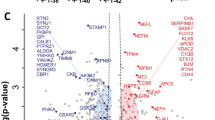Abstract
The intrahippocampal injection of amyloid beta peptide (1–42) (Aβ(1–42)) represents one of the most useful animal models of Alzheimer disease. Since none of these available models fully represents the main pathological hallmarks of Alzheimer disease, stereotaxic Aβ(1–42) infusion provides researchers with an in vivo alternative paradigm. When performed by well-trained individuals, this model is the best-suited one for short-term studies focusing on the effects of Aβ(1–42) on a specific brain region or circuitry. Here, we describe all methodological phases of such a model.
Similar content being viewed by others
References
Gaugler J, James B, Johnson T, Scholz K, Weuve J (2015) Alzheimer’s disease facts and figures. Alzheimer’s Dement 11(3):267–282
Braak H, Braak E (1988) Neuropil threads occur in dendrites of tangle-bearing nerve cells. Neuropathol Appl Neurobiol 14:39–44
Jean YY, Baleriola J, Fà M, Hengst U, Troy CM (2015) Stereotaxic infusion of oligomeric amyloid-beta into the mouse hippocampus. J Vis Exp 100:e52805. https://doi.org/10.3791/52805
Scuderi C, Stecca C, Valenza M, Ratano P, Bronzuoli MR, Bartoli S et al (2014) Palmitoylethanolamide controls reactive gliosis and exerts neuroprotective functions in a rat model of Alzheimer’s disease. Cell Death Dis 5:e1419. https://doi.org/10.1038/cddis.2014.376
Bolmont T, Clavaguera F, Meyer-Luehmann M, Herzig M, Radde R, Staufenbiel M et al (2007) Induction of tau pathology by intracerebral infusion of amyloid-β-containing brain extract and by amyloid-β deposition in APP × tau transgenic mice. Am J Pathol 171(6):2012–2020. https://doi.org/10.2353/ajpath.2007.070403
Baleriola J, Walker CA, Jean YY, Crary JF, Troy CM, Nagy PL et al (2014) Axonally synthesized ATF4 transmits a neurodegenerative signal across brain regions. Cell 158(5):1159–1172. https://doi.org/10.1016/j.cell.2014.07.001
Jean YY, Ribe EM, Pero ME, Moskalenko M, Iqbal Z, Marks LJ et al (2013) Caspase-2 is essential for c-Jun transcriptional activation and Bim induction in neuron death. Biochem J 455(1):15–25. https://doi.org/10.1042/BJ20130556
Sotthibundhu A, Sykes AM, Fox B, Underwood CK, Thangnipon W, Coulson EJ (2008) Beta-amyloid (1-42) induces neuronal death through the p75 neurotrophin receptor. J Neurosci 28(15):3941–3946. https://doi.org/10.1523/JNEUROSCI.0350-08.2008
Priest SM, Geisbuhler TP (2015) Injectable sodium pentobarbital: stability at room temperature. J Pharmacol Toxicol Methods 76:38–42. https://doi.org/10.1016/j.vascn.2015.07.012
Office of Animal Resources (2017) Institutional Animal Care and Use Committee. https://animal.research.uiowa.edu. Accessed 7 Apr 2017
Thompson AC, Kristal MB, Sallaj A, Acheson A, Martin LB, Martin T (2004) Analgesic efficacy of orally administered buprenorphine in rats: methodologic considerations. Comp Med 54(3):293–300
Paxinos G, Watson C (1998) The rat brain in stereotaxic coordinates, 4th De Luxe edn. Elsevier Science Publishing Co Inc., San Diego
Stine WB, Jungbauer L, Yu C, LaDu MJ (2011) Preparing synthetic Aβ in different aggregation states. Methods Mol Biol 670:13–32. https://doi.org/10.1007/978-1-60761-744-0_2
Acknowledgment
This work was supported by SAPIENZA University Grant to CS (prot. C26A15X58E).
Author information
Authors and Affiliations
Corresponding author
Editor information
Editors and Affiliations
Rights and permissions
Copyright information
© 2018 Springer Science+Business Media, LLC
About this protocol
Cite this protocol
Facchinetti, R., Bronzuoli, M.R., Scuderi, C. (2018). An Animal Model of Alzheimer Disease Based on the Intrahippocampal Injection of Amyloid β-Peptide (1–42). In: Skaper, S. (eds) Neurotrophic Factors. Methods in Molecular Biology, vol 1727. Humana Press, New York, NY. https://doi.org/10.1007/978-1-4939-7571-6_25
Download citation
DOI: https://doi.org/10.1007/978-1-4939-7571-6_25
Published:
Publisher Name: Humana Press, New York, NY
Print ISBN: 978-1-4939-7570-9
Online ISBN: 978-1-4939-7571-6
eBook Packages: Springer Protocols




